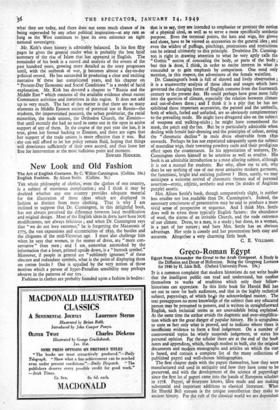New Look and Old Fashion
Tit whole philosophy of clothes, even the clothes of one country, is a subject of enormous complication ; and I think it may be doubted whether any one country provides adequate material for the illustration of those ideas which are displayed in fashion as distinct from mere clothing. That is why I am inclined to suppose that Dr. Cunnington, in this delightful book, has not always perceived the difference between local modification and original design. Most of the English ideas in dress have been local modifications, not always felicitous ; and when Dr. Cunnington says that " we do not love extremes," he is forgetting the Macaronis of 1775, the vast expansions and eccentricities of 183o, the bustles and the chignons of the mid-Victorian age. I must also challenge him when he says that women, in the matter of dress, are " more con- servative " than men ; and I am somewhat astonished by the information that a heart, printed upside down, is a " buttock symbol." Moreover, if people in general are " sublimely ignorant " of these obscure and redundant symbols, what is the point of displaying them on cotton frocks ? One is appalled by the very notion of those motives which a person of hyper-Freudian sensibility may perhaps observe in the patterns of our ties.
Fashions in clothes are probably founded upon a fashion in bodies :
that is to say, they are intended to emphasise or protract the notion of a physical ideal, as well as to serve a more specifically aesthetic purpose. Even the terminal points, the hats and wigs, the gloves and shoes, have to be viewed as accessories to the general idea ; and even the wildest of puffings, pinchings, protrusions and restrictions can be related ultimately to this principle. Doubtless Dr. Cunning- ton is right in drawing attention to what he very aptly calls the " Gothic " notion of concealing the body, or parts of the body ; but this is done, I think, in order to excite interest in what is concealed or to gain emphasis by comparison. One need only mention, in this respect, the adventures of the female waistline.
Dr. Cunnington's book is full of shrewd and lively observation ; it is a trustworthy analysis of those ideas and usages which have governed the changing forms of English costume from the fourteenth century to the present day. He could perhaps have gone more fully into the question of climate, especially the relation between climate and out-of-doors dress ; and I think it is a pity that he has not exhibited those important accessories, the parasol and the umbrella, both of which, furled and unfurled, are so obviously complementary to the prevailing mode. He might have divagated also on the subject of weapons and walking-sticks ; he might have remembered the mask, the patch and the fan. But he is particularly admirable when dealing with female hair-dressing and the principles of colour, noting the " chromatic decline " in male dress observable from 183o onwards. Perhaps he has not expatiated adequately upon the subject of masculine wigs, their towering powdery curls and their prodigious effect upon the countenance. In his appreciation of textures, Dr. Cunnington shows himself to be sensitive as well as erudite. His book is an admirable introduction to a most alluring subject, although it is not a manual for- students. But why, allow me to ask, why does he say nothing of one of our most attractive modern garments, the functional, bright and enticing pullover ? Here, surely, we may anticipate a welcome revival of chromatic themes and of personal assertion—erotic, athletic, aesthetic and even (in shades of Anglican purple) ascetic.
Mrs. Alison Settle's book, though comparatively slight, is neither less erudite nor less ,readable than Dr. Cunnington's. Indeed, the necessary conciseness of presentation may be said to produce a more vivid sense of perspective or sequence. And I think Mrs. Settle does well to stress three typically English factors : the abundance of wool, the alarms of an irritable Church, and the rude extremes of our climate. Dress, to a man, is a study ; but dress, to a woman, is a part of her nature ; and here Mrs. Settle has an obvious advantage. Her style is comely and her presentation both easy and accurate. Altogether a very charming little book.
C. E. VULI1AMY.


































 Previous page
Previous page